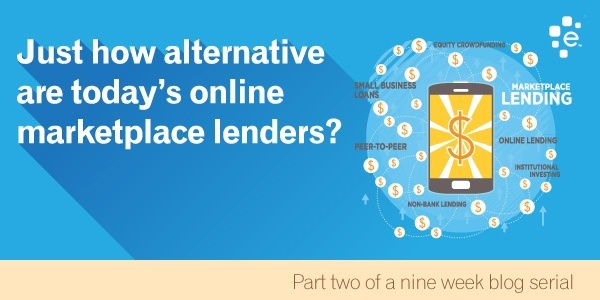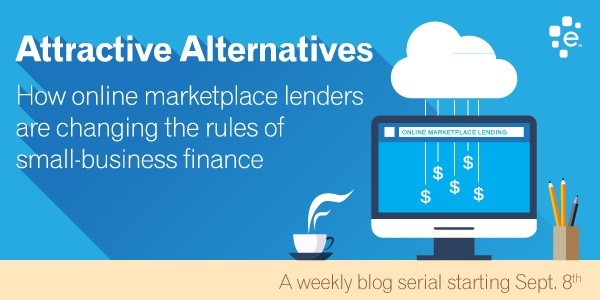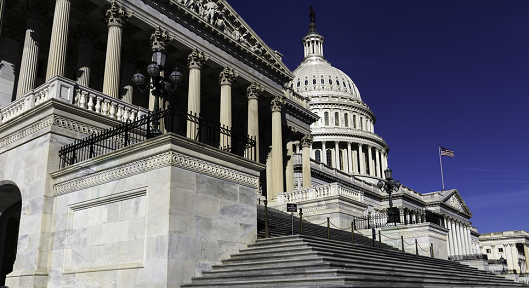Industries

This week, we invited Charles H. Green to offer his perspectives on the online marketplace lending sector. The following article is his contribution to our series on marketplace lending. The phrase “man bites dog” is an aphorism in journalism that describes how an unusual, infrequent event (such as a man biting a dog) is more likely to be reported as news than an ordinary occurrence with similar consequences, such as a dog biting a man. In other words, an event is considered more newsworthy if there is something unusual about it. Thus, the headline above likely will draw more attention than the same story with the headline “Hedge fund offers to refinance consumer loans for 7 percent APR.” While both parties might actually own a portion of the same loan portfolio in today’s “sharing economy,” known in financial services as “peer-to-peer lending,” this kind of loan is one of many that have evolved on the Internet under the new financial industry sector labeled “marketplace lending.” Online marketplace lenders, funders, and investors have caused quite a stir over the past couple of years by offering alternative financing products and platforms to serve consumers and businesses that may have trouble securing a loan from traditional financial services, i.e., banks. But what’s so radically different about what they do, other than using a Website rather than a drive-up branch to initiate a financial relationship? After all, don’t both extend money to another party with strings attached — that is, conditions about who gets the money, how much and when they promise to repay it, as well as the consequences if they don’t? It seems like a better “alternative” would be to simply win the lottery! In fact, there is plenty of “alternative” in alternative lending, and in a relatively short period of time, the results have been phenomenal for consumers and businesses alike. What’s so different? For starters, the submission process for loan applications varies greatly. Due to supervisory oversight of the industry and a conservative lending culture, applying for a bank loan often means that a more complete disclosure of personal and business information is required. The aftereffects of the Great Recession and housing bubble meant that many banks curtailed most lending altogether until their balance sheets recovered, On the flip side, online lenders process applications with very little information —generally about 40 data points. This is because these lenders leverage the information and often ask for a borrower’s authorization to gain access to the cloud, where they can acquire more data on a borrower. Furthermore, online lenders have a narrow focus on where they are willing to lend money, so their decision analytics focus more precisely on a smaller set of information that really determines the risk for that particular type of loan. This leads us to how online lenders make credit decisions. Most use proprietary algorithms that weigh various data collected from a borrower’s application and reach a decision based on the numerical score produced at that time. There’s little human intervention to sway the verdict positively or negatively since the decision matrix was developed by testing millions of blind data files with historical loan outcomes to measure and manage their exposure to credit loss. There are plenty more differences in the online lenders’ approach, but probably none more important than the customer experience. Online loan applications can be submitted 24-7, and a borrower will be “conditionally qualified” or declined usually within minutes. Final credit approval often comes within a couple of hours, and funding might be in 48 to 72 hours. How can they do it? The answer lies primarily within four factors: 1) These companies are driven by innovation, with technology used to address many aspects that we don’t like about traditional lending; 2) Online lenders are not banks, and as such, they are relatively free of the regulation that comes with accepting public deposits to fund their operations; and 3) By focusing on a smaller niche of prospective borrowers, online lenders don’t try to be everything to everybody but rather specialize to serve a smaller set of clients better. 4) These companies have developed niche products to satisfy the particular needs of each market. What happens next? Is the end of commercial banks as we know them at hand? No. While the rise of online marketplace lending has been meteoric and the industry climbed to an admirable $9 billion of funding in 2014, it is a very small portion of the trillions of dollars funded by traditional banking today. Still, what they do is attract plenty of attention in the trade. Expect to hear more about strategic partnerships, acquisitions, and other flattering forms of imitation, as the banking industry will adopt and adapt many of the inspiring improvements brought by the online marketplace lending sector. Both sides will win, but the real prize goes to consumers and small-business owners who will have a more robust and competitive environment to get financing capital in the years ahead. About Charles H. Green Charles is Managing Director of Small Business Finance Institute, which provides professional training to commercial lenders for banks and nonbanks. He has written extensively about the marketplace lending sector, including the recent Banker’s Guide to New Small Business Finance (John Wiley & Sons, 2014). Earlier in his career, he founded and served as President/CEO of Sunrise Bank of Atlanta. Related articles Just how alternative are today’s online marketplace lenders? How online marketplace lenders are changing the rules of small-business finance Self-Regulatory Program for Nonbank Small Business Lenders Top regulatory priorities for commercial lenders Playing to Your Strength - Opportunities for Regional Banks to Build Better Lending Portfolios Game Changer - How Marketplace Platforms Are Bringing Financial Institutions Back to Small-Business Lending Marketplace Matchmakers - How Loan Aggregators Bring Borrowers and Lenders Together New Frontiers - What's Next For Marketplace Lending?

Disruptive technology has radically changed how we shop, socialize, book vacation rentals — and even how we hail a cab. Now we have another Web-based disrupter upending yet one more venerable American institution: how we secure small-business loans. Over the past two to three years, online marketplace lending (OML) — also called alternative lending — has made dramatic changes in the landscape of financing businesses. Companies like OnDeck, Kabbage, Funding Circle, CanCapital, Lending Club and dozens of others have created what amounts to a $1 trillion market, according to a recent article on TechCrunch. This doesn’t mean that OML is going to send traditional banks the way of typewriter and buggy whip makers. Your neighborhood bank branch and small-business lender still do and will have an important function to perform. But strict regulation and rigid business models within the traditional lending industry have left major gaps when it comes to funding activity in the small-business marketplace. It is in these voids that creative and aggressive entrepreneurs are finding not only amazing business opportunities, but also an entire class of customer that until now has been grossly underserved. What is online marketplace lending all about? How does it work? Why is it so attractive? Who are the customers? And why now? The answers to all these questions lie in one of those serendipitous confluences of economic necessity, technological advancement and entrepreneurial creativity that creates a paradigm shift in what we believe is possible. The result is a new model for commercial financing that may soon become the primary medium many small to medium-size companies use to secure the capital they need to grow and prosper. Over the next eight weeks, Experian® will deep dive into the State of Online Marketplace Lending, examining the lending market from all sides, piecing it together with opinions from thought leaders throughout the space and publishing our findings in a compendium ebook. Let’s begin by tracing this trend to its source. The roots of online marketplace lending It is said that the Chinese character for disaster is the same as that for opportunity. If so, then it makes sense that the disastrous Great Recession of 2008 to 2010 should serve as the crucible from which the alternative lending industry should spring. When the economy crashed in 2008, the Western financial industry responded by replacing its overly lax lending requirements with regulations and lending standards so strict that many businesses, especially younger or smaller ones, found it all but impossible to secure financing under any conditions. Having been burned by their formerly liberal attitudes, banks and other traditional lenders decided the best way to minimize risk was to avoid lending to all but their most financially secure customers. (In other words, the only way to get a loan was to prove you didn’t need one.) Enter the online marketplace lenders. OMLs — particularly peer-to-peer lenders — began to appear a year or so before the market crashed. The rise of Facebook and similar social media platforms coupled with rapid advances in Big Data management allowed those with capital to quickly qualify potential customers via the Internet and issue short-term loans without the red tape and regulations that made borrowing from banks such a challenge. "Technology is what has made online lending possible, online lenders benefit from having a much lower cost basis than banks. As a result, they can price their loans differently. And they can often make their lending decisions on the same day they receive an application.” Laura DeSoto Senior V.P. Strategic Initiatives Once the Great Recession hit in force, small and medium-size businesses, finding that traditional capital sources had dried up like Lake Shasta in the California drought, flocked to these aggressive start-ups en masse. OML marketing messages soon became ubiquitous, ranging from 30-second radio spots to robocalls to business owners’ cell phones. Web-based payment services like PayPal began to offer their own business capital lending programs. To the surprise of the cynics, many of the new lending platforms actually worked. Businesses were able to borrow the funds they needed. Lenders enjoyed solid returns on their investments. And consumers reaped the benefits of an economy offering a broader range of goods and services. Today, OML looks like it’s here to stay — which is not to say that banks have reason to panic. “It’s important to note that many online lenders actually get their funds from traditional banks,” DeSoto stated. “Some people call OMLs ‘shadow banks’ because they’re able to use banks’ funds in ways that are not subject to all the same federal regulations.” What makes online lending “alternative” It is not just the source of the loans that distinguishes alternative lending from traditional commercial banking. The method, speed, qualifications and form of the loans themselves are also distinctive. As the name implies, online lending is done via the Internet. Borrowers need not walk into a brick-and-mortar bank to fill out reams of mind-numbing paperwork. Instead, they need only fill out a usually brief online application and attach whatever documentation the lender requires. What kind of documentation? Often, alternative lenders don’t require the detailed financial statements and tax returns commercial banks demand. Instead, a month or two of retail receipts may be all that’s necessary. This is because many alternative loans are not the long-term, interest-based instruments to which we’re accustomed. Instead, many alternative lenders use “factoring” or revenue-based lending in which they take a small portion of each sale as repayment on the loan. Steady cash flow is more important than yearly sales volume or annual profits/losses. Another popular vehicle is so-called “peer-to-peer” lending that often involves small loans of $5,000 to $50,000 with terms of just one to five years. And now that online lending has become legitimate in the eyes of many, we’re seeing loans or “working capital advances” in the millions of dollars. Like the most sophisticated banks, many OMLs — even some of the smaller ones — have access to advanced algorithms that allow them to evaluate a potential borrower’s suitability based on readily available business credit data in addition to cash flow, and activity data. But because their systems are mostly or even totally automated, OMLs can prequalify applicants in a matter of hours, if not minutes. Following prequalification, additional documentation may still be necessary before a loan is approved. Of course, the larger the loan, the more documentation lenders require. Online lending reduces paperwork, but it doesn’t eliminate it altogether. “Some companies still rely partly on manual application reviews. Some even promote their ‘live’ customer service,” DeSoto noted. “Still, it probably won’t be long before most online lending is 100 percent automated.” Are you a candidate for online marketplace lending? The ideal candidate for today’s online marketplace lending is a small to medium-size retail or commercial B2B company with a steady cash flow and a need for small, quick cash infusions to buy new capital equipment, hire new personnel or otherwise expand operations. Restaurants, retail stores, and B2B service companies like office equipment suppliers and marketing/ad agencies fit this profile perfectly. Because cash flow is essential, most marketplace lenders are not interested in financing start-ups. These are still the purview of venture capitalists. Most online lenders also are not interested in manufacturing companies that make perhaps one or two large sales every couple of months. Expanding the market, not cannibalizing it DeSoto stressed that online lenders are not taking business away from traditional lenders but are serving customers who probably would not qualify for traditional business loans. As such, they’re expanding the market, not cannibalizing it. “Most small businesses that have been in business just one or two years wouldn’t even be on a commercial bank’s radar,” she noted. “These people would otherwise have to rely on friends, family or personal credit for funds. Online lending offers opportunities that simply did not previously exist.” The role of business credit information The role of business credit information — including any history of missed payments, delinquencies, pending judgments, bankruptcies and overextended lines of credit — is obviously critical to marketplace lenders’ ability to quickly and accurately assess risk and advance capital responsibly. “Experian, the industry leader in consumer and business credit reporting, is proud of the part we play in making marketplace financing available to thousands of businesses nationwide and of the good this new and growing industry sector is doing to expand the economy” Laura DeSoto concluded. So in summary, a few key points about online marketplace lending: Online applications usually are fast and simple and require minimal documentation Technology allows lenders to prequalify borrowers in hours, sometimes minutes Loans can be as low as a few thousand dollars or as high as several million dollars Most lenders eschew traditional long-term interest rates in favor of cash flow or other short-term repayments Prime customers are small, younger retail or services businesses with high, consistent cash flow Online lending is expanding the market, creating opportunities where none existed previously In future articles, we will dive even deeper into the world of alternative and online lending, identifying the major players, looking closer at the risks and benefits, and predicting as best we can where the industry is headed. Next week, Charles H. Green from AdviceOnLoan will join us to examine how different yet similar online marketplace lending is to traditional lending. Related articles Just how alternative are today’s online marketplace lenders? How online marketplace lenders are changing the rules of small-business finance Self-Regulatory Program for Nonbank Small Business Lenders Top regulatory priorities for commercial lenders Playing to Your Strength - Opportunities for Regional Banks to Build Better Lending Portfolios Game Changer - How Marketplace Platforms Are Bringing Financial Institutions Back to Small-Business Lending Marketplace Matchmakers - How Loan Aggregators Bring Borrowers and Lenders Together New Frontiers - What's Next For Marketplace Lending?

Imagine for a moment a young parent who has been laid off from their job. After months of looking for work they still have not found a job. To make ends meet they start doing landscape work for neighbors in the area, eventually jump-starting a landscaping business to provide for their family. With some hard work, they start to build up a clientele in the local neighborhood. While they are starting to get back on their feet slowly, they realize at the current rate, the business will not completely meet the needs of their young family. If they could borrow just $3,000 to buy some more mowers and trimmers, however, they could hire two friends and double the size of the business. With that in mind, let’s assume that they have a mediocre credit score, their credit card has a credit limit of $1,000 and they are maxed out. Furthermore, they don’t own a home to borrow against, and the loan size they are seeking is too small for a bank to even consider. However, if they could get a $3,000 loan, they could expand their business, create two new jobs and better provide for their family. There are folks just like the person described above all across the country looking for help. But where do they turn? Alternative financing options provide an avenue for entrepreneurs and other small business owners looking for commercial funding, who are otherwise turned down from more traditional financial institutions, such as banks and credit unions. By leveraging business credit data from credit bureaus, such as Experian, as well as other data sources, alternative financers are able to make lending decisions and extend credit to this segment of small business owners, enabling them to finance their company’s growth, ultimately stimulating the economy. One example of an alternative financer using such data to help open opportunity for small businesses is Opportunity Fund, a non-profit micro lender in California. Otherwise known as Community Development Financial Institutions, these micro lenders aim to create economic opportunity for underprivileged businesses in the U.S. And the need for these alternative financial institutions in California is critical. Despite recent upticks in our economy nationwide, things are still very tough in the Golden State. New data released by the Corporation for Enterprise Development (CFED) show many Californians are still struggling to gain a foothold in the economic recovery. CFED’s 2015 Assets & Opportunity Scorecard ranked California 50th among all states and the District of Columbia, for its large number (15.8 percent) of underemployed workers, 49th for both its home ownership and housing affordability rates, and dead last (51st) for high school degree attainment. Source: Corporation for Enterprise Development (CFED) Needless to say, there are a number of small business owners in California looking for financing to help grow their business. Organizations like Opportunity Fund help these business owners find affordable funding, and educate them on what they need to know about expanding. How alternative financers are helping? Opportunity Fund CEO, Eric Weaver & Rosa Funes A prime example of how alternative finance options are helping small businesses is the story of Paradise Flowers and Gifts. In Opportunity Fund’s most recent video, CEO Eric Weaver describes first meeting Rosa Funes, and how she described her longtime love of flowers. As a loan officer at the time, Eric described going to Rosa’s home and knocking on her door. She needed $500 to start a flower business. The amount was smaller than they had ever considered, but Eric was so moved by her story and her drive that he looked at her and said “Yes”, and told her “Rosa, you have a dream, don’t stop.” Alternative finance options, like Opportunity Fund are working hard every day to help small business owners and entrepreneurs gain the financial footing they need to succeed. After all, they are the backbone of our economy. The work that Opportunity Fund and other alternative financers have done will create a powerful ripple effect to drive economic opportunity across California, and the rest of the country. It’s the perfect example of how data can be used for the betterment of society and helps these smaller entrepreneurs grow.

In many cases, business lenders often rely on the commercial credit of the enterprise coupled with the personal credit of the business’s owner when making lending decisions. This is especially true for sole proprietorships and partnerships. To that end, regulatory action and public policy initiatives aimed at consumer credit often times can have a direct impact on commercial lenders. This blog takes a look at some of the top regulatory priorities for business lenders within the credit ecosystem. Ensuring the accuracy of credit data Over the past two years, the Consumer Financial Protection Bureau (CFPB) has taken several actions to make clear that it believes data furnishers — including lenders — are responsible for ensuring the accuracy of the credit data that they report to credit reporting agencies (CRAs). The CFPB issued two bulletins — in September 2013 and February 2014 — reminding data furnishers of their responsibilities under the Fair Credit Reporting Act (FCRA) and the need to properly conduct investigations when a consumer disputes an inaccuracy. The CFPB backed up these bulletins with an August 2014 enforcement action against a lender that it said failed to fix flaws in its software system that were causing it to report inaccurate credit data to the CRAs. Debt collection practices remain in the spotlight Another top focus of regulators that may overlap with small business lending is increased scrutiny of the debt collection market. Within the collections industry, the CFPB has focused on problems related to how information about a debt is transferred from a first party to an outside agency or debt buyer, as well as the standards and timing of when a collections item goes onto a consumer’s credit report. To that end, in December 2014 the CFPB announced that it was requesting the national credit bureaus to provide regular accuracy reports that highlight key risk areas, including disputes, for consumers. The CFPB will use these reports to help prioritize their work on accuracy metrics, including: furnishers and industries with the most overall disputes; and furnishers with high disputes relative to their industry peers. The CFPB also released an Advanced Notice of Proposed Rulemaking (ANPR) in November 2013, covering a wide array of complex issues within the debt collection market. It’s expected that they will release the first version of its proposed rule for the collection market in late 2015 – early 2016. Policies boosting financial inclusion are also critical for business lending Commercial lenders should also pay attention to efforts by policymakers to improve financial access for the more than 60 million American consumers that either have a thin credit history or no credit data at all. In the case of an entrepreneur, a thin or no hit credit file would make it much more difficult to access affordable capital. One way to improve the ability for unbanked individuals to access affordable credit is through the reporting of on-time payments made to utility, telecommunication and rental companies by consumers — often referred to as “alternative credit data.” While they have long made pricing decisions based upon the full-file credit data furnished by creditors, historically telecom and utility companies have only provided negative data — i.e. late payments or if an account is in collection. Including both positive and negative data from these sources will enable tens of millions of thin-file consumers — and small business owners — with a proven record of meeting financial obligations to access fair and affordable credit. The CFPB weighed in on the importance of including alternative data in a 2013 report on financial empowerment. Bipartisan legislation has been introduced the past two sessions of Congress that would clarify federal law to encourage utilities and telecom providers to report positive credit data to the nation’s credit bureaus. Coming soon: CFPB data collection on women and minority owned businesses Small business lenders are also keeping a close eye on the development of the new data collection requirements under the Dodd-Frank Act. Despite the CFPB being primarily focused on consumer lending, the agency was tasked with implementing a provision of the Dodd-Frank Act that required lenders to ask small business applicants if the business was women or minority-owned. The problem is that this question is currently prohibited under Equal Credit Opportunity Act (ECOA), as a creditor cannot inquire about the race, color, religion, ethnicity or sex of an applicant. The CFPB will ultimately have to provide guidance to help resolve the conflict between these two laws. While this new sweeping data collection mandate will not become effective until the CFPB adopts the necessary regulations, it’s easy to see how this could ultimately impact small business lenders. As many have said before, small businesses are the lifeblood of our economy, but they need funds to grow. We’ll want to keep a close eye on each of these initiatives, as the regulatory impact can be huge for small business lenders, and the ability for small businesses to access capital.
